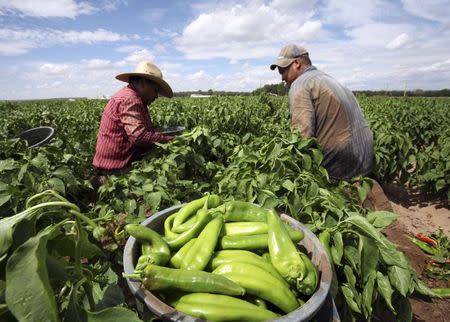Imports, small harvest hit famed New Mexico chile peppers
By Joseph Kolb ALBUQUERQUE N.M. (Reuters) - The green chile peppers roasting aromatically outside an Albuquerque supermarket are perhaps New Mexico's most famed and recognizable product. But these pungent palate pleasers are under threat from shrinking harvests and tough competition from foreign imports. "It's the essence of New Mexico," said Shawn Barela, a lover of chile peppers just having made a five-hour round trip to Hatch, a village in Dona Ana County world renown for the quality of its chile. "It's got a unique taste you can't find anyplace else," Barela said, watching a store clerk turn a large metal drum to roast one of the two 40-pound sacks of green chiles he had brought back with him. The annual chile festival in Hatch, which has fewer than 2,000 residents, is an exuberant affair that each Labor Day draws 10 times that number of visitors. September is marked by the aroma of roasting chile in supermarket parking lots and on backyard grills throughout New Mexico. Locals bring peppers to rotate in large barrels over a propane flame, slowly darkening the skin from green to light brown in a process that not only brings out their flavor but helps preserve the chiles for freezing and use in meals for much of the rest of the year. Year-round sunshine in the southern part of the state, combined with nutrient rich soil in the Hatch Valley, make home-grown chiles the finest in the world, locals say. But few like to talk about the diminishing crop. The size of the New Mexico chile pepper harvest shrank by more than 40 percent over the last decade, from nearly 110,000 tons in 2004 to some 65,000 tons in 2013, according to the U.S. and New Mexico Departments of Agriculture. The crop's value also has seen a sharp decline. In 2012, New Mexico chile farmers brought in a total of $65.4 million, compared with last year's estimated $49.5 million. "I don't think we'll ever stop growing chile here on a small level, but our nationwide market is definitely endangered," said Jaye Hawkins, administrator at the New Mexico Chile Association, which advocates on behalf of local growers. HOT COMPETITION Hawkins attributed the beginning of the local crop's decline to the North American Free Trade Agreement in the mid 1990s which flooded the market with Mexican chile. Rival growers in nations such as China, India and Peru also benefit from lower labor and production costs. "These are really large challenges that make it difficult for us to compete," Hawkins said. More than 4,000 full-time and thousands of part-time seasonal workers are employed in chile farming in New Mexico. Hawkins said she feared for their future if the competition from overseas heats up. About 82 percent of chile peppers consumed in the United States are now imported, and producers in New Mexico have had to fight to make their brand stand apart - in much the way farmers label "Florida" oranges or "California" grapes. In 2012, the state legislature signed into law the New Mexico Chile Advertising Act, which prohibits marketing peppers produced in other states as authentic New Mexico chile. The law, enforced by the state's Department of Agriculture, requires restaurants to post prominently that the chile peppers used in their meals were grown elsewhere. Failure to comply can result in a "stop sale" order, and Hawkins estimated that nearly two dozen summonses have been issued so far. "This helps us raise awareness that chile advertised as being from New Mexico is actually from New Mexico," she said. "It helps bring the brand back." (Reporting by Joseph Kolb; Editing by Daniel Wallis, Jill Serjeant and Gunna Dickson)



